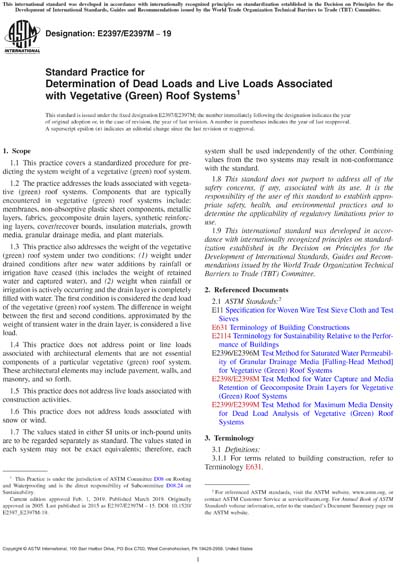Most recent
ASTM E2397/E2397M-19
Standard Practice for Determination of Dead Loads and Live Loads Associated with Vegetative (Green) Roof Systems
1.1 This practice covers a standardized procedure for predicting the system weight of a vegetative (green) roof system.
1.2 The practice addresses the loads associated with vegetative (green) roof systems. Components that are typically encountered in vegetative (green) roof systems include: membranes, non-absorptive plastic sheet components, metallic layers, fabrics, geocomposite drain layers, synthetic reinforcing layers, cover/recover boards, insulation materials, growth media, granular drainage media, and plant materials.
1.3 This practice also addresses the weight of the vegetative (green) roof system under two conditions: (1) weight under drained conditions after new water additions by rainfall or irrigation have ceased (this includes the weight of retained water and captured water), and (2) weight when rainfall or irrigation is actively occurring and the drain layer is completely filled with water. The first condition is considered the dead load of the vegetative (green) roof system. The difference in weight between the first and second conditions, approximated by the weight of transient water in the drain layer, is considered a live load.
1.4 This practice does not address point or line loads associated with architectural elements that are not essential components of a particular vegetative (green) roof system. These architectural elements may include pavement, walls, and masonry, and so forth.
1.5 This practice does not address live loads associated with construction activities.
1.6 This practice does not address loads associated with snow or wind.
1.7 The values stated in either SI units or inch-pound units are to be regarded separately as standard. The values stated in each system may not be exact equivalents; therefore, each system shall be used independently of the other. Combining values from the two systems may result in non-conformance with the standard.
1.8 This standard does not purport to address all of the safety concerns, if any, associated with its use. It is the responsibility of the user of this standard to establish appropriate safety, health, and environmental practices and to determine the applicability of regulatory limitations prior to use.
1.9 This international standard was developed in accordance with internationally recognized principles on standardization established in the Decision on Principles for the Development of International Standards, Guides and Recommendations issued by the World Trade Organization Technical Barriers to Trade (TBT) Committee.
Content Provider
ASTM International [astm]






